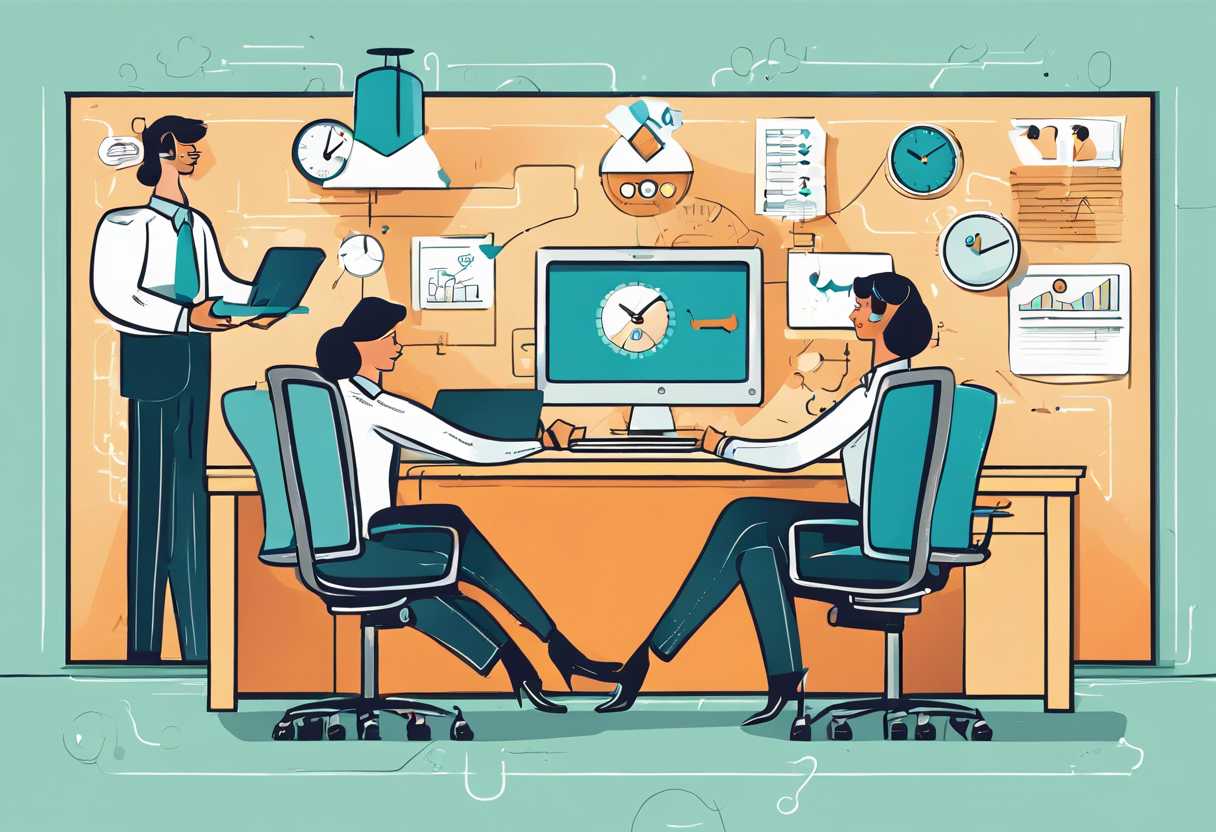Welcome to Chapter 3 of our comprehensive guide on managing a customer service team. In this chapter, we will delve into the crucial aspects of effective leadership, strategies for building a high-performing team, training and development programs, leveraging technology, and addressing challenges and conflict resolution in customer service management.
Effective leadership is the cornerstone of successful customer service management. We will explore the importance of strong leadership and how it impacts the overall performance of the team. Additionally, we will discuss strategies for building a high-performing customer service team, including recruitment, team building, and fostering a positive work culture.
Training and development programs are essential for achieving customer service excellence. We will provide insights into implementing effective training programs to enhance the skills and knowledge of your team members. Furthermore, we will explore the role of technology in enhancing customer service team performance, including the use of customer relationship management (CRM) systems and other tools.
Finally, we will address the challenges and conflict resolution in customer service team management. We will provide practical tips for handling difficult situations and maintaining a positive work environment.
Stay tuned as we dive deeper into each of these topics, providing valuable insights and actionable strategies for managing a high-performing customer service team.
The Importance of Effective Leadership in Customer Service Management
Setting the Tone for Customer Service Excellence
Effective leadership in customer service management is crucial for setting the tone and expectations for the entire team. Leaders who prioritize customer satisfaction and demonstrate a commitment to providing exceptional service inspire their team members to do the same. By leading by example, managers can create a culture of excellence that permeates throughout the entire customer service department.
Empowering and Motivating Customer Service Representatives
Strong leadership in customer service management involves empowering and motivating customer service representatives to excel in their roles. When leaders provide the necessary support, resources, and training, customer service representatives feel more confident and capable in their interactions with customers. This, in turn, leads to improved customer satisfaction and loyalty.
Fostering a Positive Work Environment
Effective leadership in customer service management also plays a significant role in fostering a positive work environment. When leaders prioritize open communication, collaboration, and recognition of achievements, customer service representatives feel valued and motivated to perform at their best. A positive work environment not only benefits employee morale but also translates into better customer experiences.

Strategies for Building a High-Performing Customer Service Team
Hiring the Right People
Building a high-performing customer service team starts with hiring the right people. Look for individuals who not only have the necessary skills and experience but also possess strong communication and problem-solving abilities. It’s important to assess candidates’ emotional intelligence and their ability to empathize with customers. Additionally, consider implementing behavioral assessments or role-playing exercises during the interview process to gauge how candidates handle real-life customer service scenarios.
Providing Ongoing Training and Development
Investing in ongoing training and development for your customer service team is crucial for maintaining high performance. Regular training sessions can help employees stay updated on the latest industry trends, best practices, and new technologies. Consider offering opportunities for professional development, such as workshops, webinars, or certifications, to help your team members enhance their skills and knowledge. By continuously investing in their growth, you can ensure that your customer service team remains adaptable and capable of meeting evolving customer needs.
Implementing Effective Communication and Feedback Systems
Effective communication and feedback systems are essential for building a high-performing customer service team. Encourage open and transparent communication among team members, as well as between employees and management. Establish regular feedback mechanisms, such as performance evaluations or one-on-one meetings, to provide constructive feedback and recognize outstanding performance. Additionally, consider implementing a customer feedback system to gather insights on the team’s performance and identify areas for improvement.

Implementing Training and Development Programs for Customer Service Excellence
The Importance of Customer Service Training
Customer service is a critical aspect of any business, as it directly impacts customer satisfaction and loyalty. Implementing training and development programs for customer service excellence is essential to ensure that employees have the necessary skills and knowledge to provide exceptional service to customers. These programs can help improve communication, problem-solving, and conflict resolution skills, ultimately leading to a better overall customer experience.
Key Components of Effective Training Programs
When developing training programs for customer service excellence, it’s important to consider several key components. First, the training should be tailored to the specific needs and challenges of the organization and its customer base. This may include role-playing exercises, case studies, and interactive workshops to simulate real-world scenarios. Additionally, ongoing training and development should be a priority, as customer service best practices and industry standards are constantly evolving.
Another crucial component is the use of technology to enhance training programs. This may include e-learning modules, virtual reality simulations, or mobile apps for on-the-go learning. By incorporating technology into training, organizations can provide flexible and accessible learning opportunities for their employees.
Measuring the Impact of Training Programs
It’s essential to measure the impact of training and development programs for customer service excellence to ensure their effectiveness. This can be done through various methods, such as customer satisfaction surveys, mystery shopping evaluations, and employee performance metrics. By collecting and analyzing data on customer feedback and employee performance, organizations can identify areas for improvement and make data-driven decisions to enhance their training programs.
| Method | Benefits |
| Customer satisfaction surveys | Direct feedback from customers on their service experience |
| Mystery shopping evaluations | Objective assessments of customer service quality |
| Employee performance metrics | Quantitative data on employee productivity and effectiveness |
Utilizing Technology to Enhance Customer Service Team Performance
Implementing Customer Relationship Management (CRM) Software
One of the most effective ways to enhance customer service team performance is by implementing a robust CRM software. This technology allows customer service representatives to access customer information, purchase history, and previous interactions, enabling them to provide personalized and efficient support. With CRM software, teams can also track customer inquiries, monitor response times, and identify areas for improvement.
Integrating Chatbots for Instant Support
Integrating chatbots into customer service operations can significantly enhance team performance by providing instant support to customers. Chatbots can handle routine inquiries, freeing up human agents to focus on more complex issues. Additionally, chatbots can gather initial information from customers, allowing human agents to step in with a better understanding of the customer’s needs. This technology not only improves response times but also ensures consistent and accurate support.
Utilizing Data Analytics for Performance Evaluation
Utilizing data analytics tools can provide valuable insights into customer service team performance. By analyzing metrics such as customer satisfaction scores, response times, and resolution rates, managers can identify trends and areas for improvement. This data-driven approach allows for targeted training and coaching, ultimately leading to a more efficient and effective customer service team.
Addressing Challenges and Conflict Resolution in Customer Service Team Management
Identifying Common Challenges in Customer Service Team Management
Customer service team management comes with its fair share of challenges. From high turnover rates to communication breakdowns, it’s important to identify and address these challenges to ensure a smooth-running team. One common challenge is managing a diverse team with different personalities and work styles. This can lead to conflicts and misunderstandings if not managed properly. Additionally, dealing with irate customers and handling high-stress situations can take a toll on the team’s morale and productivity.
Implementing Conflict Resolution Strategies
When conflicts arise within the customer service team, it’s crucial to have effective conflict resolution strategies in place. One approach is to encourage open communication and active listening among team members. This can help in understanding each other’s perspectives and finding common ground. Another strategy is to establish clear guidelines and protocols for resolving conflicts, ensuring that all team members are aware of the process and feel supported in addressing issues. Additionally, providing training on emotional intelligence and de-escalation techniques can equip the team with the skills needed to handle challenging situations with customers and each other.
Utilizing Data and Metrics for Continuous Improvement
One way to address challenges and improve conflict resolution in customer service team management is by leveraging data and metrics. By tracking key performance indicators such as customer satisfaction scores, response times, and resolution rates, managers can identify areas for improvement and implement targeted solutions. Additionally, conducting regular team assessments and feedback sessions can provide valuable insights into the team dynamics and areas that require attention. By using data-driven approaches, managers can make informed decisions and continuously improve the team’s performance and overall satisfaction.
Conclusion
Chapter 3: Managing a Customer Service Team has provided valuable insights into the key aspects of effective leadership, team building, training, technology utilization, and conflict resolution in customer service management. As a customer service leader, it is crucial to understand the significance of strong leadership in driving team performance and fostering a culture of excellence.
By implementing strategies for building a high-performing customer service team, such as setting clear goals, providing regular feedback, and promoting collaboration, organizations can create a motivated and productive workforce. Additionally, the implementation of training and development programs plays a pivotal role in equipping customer service representatives with the necessary skills and knowledge to deliver exceptional service.
Utilizing technology to enhance customer service team performance is essential in today’s digital age. From implementing customer relationship management (CRM) systems to leveraging AI-powered chatbots, technology can streamline processes, improve response times, and enhance the overall customer experience.
Addressing challenges and conflict resolution in customer service team management is a critical aspect of leadership. By fostering open communication, promoting empathy, and implementing effective conflict resolution strategies, leaders can create a harmonious and supportive work environment.
As you continue to manage your customer service team, remember that continuous improvement and adaptation to changing customer needs are key to success. Embrace innovation, invest in your team’s development, and prioritize the delivery of exceptional customer service. By doing so, you can elevate your team’s performance and drive long-term customer satisfaction.
Thank you for reading Chapter 3: Managing a Customer Service Team. We hope that the insights shared in this blog post will empower you to lead your customer service team to new heights of success. If you have any questions or would like to explore further resources on this topic, feel free to reach out to us. Here’s to building a customer service team that exceeds expectations and delivers outstanding results!

